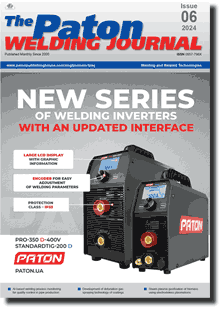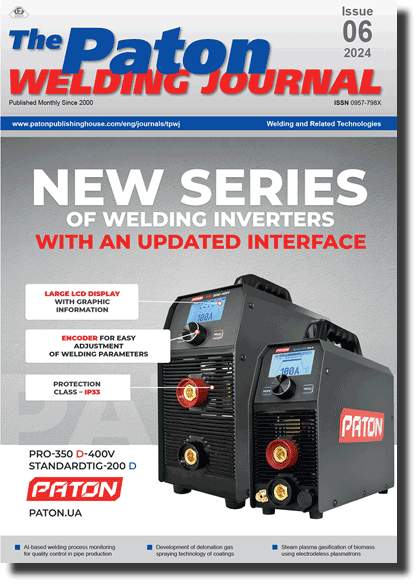| 2024 №06 (03) |
DOI of Article 10.37434/tpwj2024.06.04 |
2024 №06 (05) |

The Paton Welding Journal, 2024, #6, 29-37 pages
Influence of solid-state laser radiation on the process of pulsed-arc welding of aluminium alloy 1561
Y. Zhao, X. Wang, Z. Liu, V. Khaskin
Guangdong Provincial Key Laboratory of Advanced Welding Technology, China-Ukraine Institute of Welding, Guangdong Academy of Sciences, Guangzhou, 510650, China. E-mail: khaskin1969@gmail.comAbstract
The results of consumable electrode pulsed-arc welding of aluminium alloy 1561 of 6 mm thickness (P-MIG) with and without addition of focused radiation of the Nd:YAG laser were analyzed. During laser-P-MIG welding, the influence of the arc energy source improves absorption of laser radiation and promotes high-quality formation of the weld reinforcement, and the influence of the laser source leads to an increase in the depth of penetration due to the formation of a vapour-gas channel (keyhole) and to a decrease in the current density of the anode region of the arc on the electrode wire, which reduces emissions of welding aerosols. Factors influencing the effectiveness of laser radiation during laser-P-MIG welding were determined. It is shown that an increase in laser power leads to an increase in arc voltage with a simultaneous decrease in welding current. Formation of high-quality welds by P-MIG welding of alloy 1561 requires an energy input of 4.5…5.0 kJ/cm. Here, a regular structure of the weld metal with the dendritic parameter of 13…15 μm and joint strength of 90…92 % of the strength of the base metal is formed. Introduction of focused radiation of a 3.0 kW Nd:YAG laser into the welding process allows reducing the energy input by approximately half, due to which the dendritic parameter decreases to 10 μm, and the strength of the joints increases to 93…96 % of base metal strength.
Keywords: aluminum alloy, consumable electrode pulsed arc welding (P-MIG), Nd:YAG-laser radiation, modes, welding aerosols, structures, strength.
Received: 30.04.2024
Received in revised form: 05.06.2024
Accepted: 22.07.2024
References
1. Benedyk, J.C. (2010) 3 - Aluminium alloys for lightweight automotive structures. In: Woodhead Publishing Series in Composites Science and Engineering, Materials, Design and Manufacturing for Lightweight Vehicles, 79-113. Ed. by P.K. Mallick. Woodhead Publishing. https://doi.org/10.1533/9781845697822.1.792. Sun, Y. (2023) The use of aluminium alloys in structures: Review and outlook. Structures, 57(5), 105290. https://doi.org/10.1016/j.istruc.2023.105290
3. Hung, F.-S. (2020) Design of lightweight aluminium alloy building materials for corrosion and wear resistance. Emerging Materials Research, 9(3), 750-757. https://doi.org/10.1680/jemmr.19.00177
4. Ambriz, R.R., Mayagoitia, V. (2011) Welding of aluminium alloys. In: Recent Trends in Processing and Degradation of Aluminium Alloys, 516, 63-86. Ed. by Prof. Zaki Ahmad. https://doi.org/10.5772/18757
5. Khaskin, V.Y. (2013) Development of laser welding of aluminium alloys at the E.O. Paton Electric Welding Institute. The Paton Welding J., 5, 51-55.
6. Bushma, A.I. (2015) State-of-the-art of hybrid laser-plasma welding (Review). The Paton Welding J., 8, 18-25. https://doi.org/10.15407/tpwj2015.08.04
7. Bunaziv, I., Akselsen, O. M., Salminen, A., Unt, A. (2016) Fiber laser-MIG hybrid welding of 5 mm 5083 aluminium alloy. J. Materials Proc. Technology, 233, 107-114. https://doi.org/10.1016/j.jmatprotec.2016.02.018
8. Sánchez-Amaya, J. M., Pérez, T. D., Rovira, L. G., Botana, J. (2009) Laser welding of aluminium alloys 5083 and 6082 under conduction regime. Appl. Surface Sci., 255(23), 9512-9521. https://doi.org/10.1016/j.apsusc.2009.07.081
9. Jiang, Z., Hua, X., Huang, L. et al. (2018) Double-sided hybrid laser-MIG welding plus MIG welding of 30-mm-thick aluminium alloy. Int. J. Adv. Manuf. Technol., 97, 903-913. https://doi.org/10.1007/s00170-018-1997-7
10. Babych, O.A., Korzhyk, V.M., Grynyuk, А.А. et al. (2020) Hybrid welding of aluminium 1561 and 5083 alloys using plasma-arc and consumable electrode arc (Plasma-MIG). The Paton Welding J., 7, 11-22. https://doi.org/10.37434/tpwj2020.07.02
11. Krivtsun, I.V., Khaskin, V.Yu., Korzhik, V.N., Luo, Ziyi (2015) Industrial application of hybrid laser-arc welding (Review). The Paton Welding J., 7, 41-46. https://doi.org/10.15407/tpwj2015.07.07
12. (2018) Encyclopedia of aluminium and its alloys. 2 Vols Ed. by G.E. Totten et al., 1st Ed. Boca Raton, CRC Press. https://doi.org/10.1201/9781351045636
13. DuPont, J.N., Marder, A.R. (1995) Thermal efficiency of arc welding processes. Welding J., 74, 406-416.
14. Hälsig, A., Mayr, P. (2013) Energy balance study of gas-shielded arc welding processes. Welding in the World, Le Soudage dans le Monde, 57(5). https://doi.org/10.1007/s40194-013-0073-z
15. De Oliveira, A.F.M., dos S. Magalhães, E., dos S. Paes, L.E. et al. (2023) A thermal analysis of laser beam welding using statistical approaches. Processes, 11(7). https://doi.org/10.3390/pr11072023
16. Levchenko, O.G., Mashin, V.S. (2003) Sanitary-hygienic characteristic of process of consumable electrode inert-gas welding of AMg6 aluminium alloy. The Paton Welding J., 1, 46-48.
17. Cole, H., Epstein, S., Peace, J. (2007) Particulate and gaseous emissions when welding aluminium alloys. J. of Occupational and Environmental Hygiene, 4(9).2 https://doi.org/10.1080/15459620701516162
Suggested Citation
Y. Zhao, X. Wang, Z. Liu, V. Khaskin (2024) Influence of solid-state laser radiation on the process of pulsed-arc welding of aluminium alloy 1561. The Paton Welding J., 06, 29-37.The cost of subscription/purchase order journals or individual articles
| Journal/Currency | Annual Set | 1 issue printed |
1 issue |
one article |
| TPWJ/USD | 384 $ | 32 $ | 26 $ | 13 $ |
| TPWJ/EUR | 348 € | 29 € | 24 € | 12 € |
| TPWJ/UAH | 7200 UAH | 600 UAH | 600 UAH | 280 UAH |
| AS/UAH | 1800 UAH | 300 UAH | 300 UAH | 150 UAH |
| AS/USD | 192 $ | 32 $ | 26 $ | 13 $ |
| AS/EUR | 180 € | 30 € | 25 € | 12 € |
| SEM/UAH | 1200 UAH | 300 UAH | 300 UAH | 150 UAH |
| SEM/USD | 128 $ | 32 $ | 26 $ | 13 $ |
| SEM/EUR | 120 € | 30 € | 25 € | 12 € |
| TDNK/UAH | 1200 UAH | 300 UAH | 300 UAH | 150 UAH |
| TDNK/USD | 128 $ | 32 $ | 26 $ | 13 $ |
| TDNK/EUR | 120 € | 30 € | 25 € | 15 € |
AS = «Automatic Welding» - 6 issues per year;
TPWJ = «PATON WELDING JOURNAL» - 12 issues per year;
SEM = «Electrometallurgy Today» - 4 issues per year;
TDNK = «Technical Diagnostics and Non-Destructive Testing» - 4 issues per year.


